Koyo in Kyoto: Perfect Spots to See the Red Leaves!
James Lau
Posted on September 12, 2024
Share:
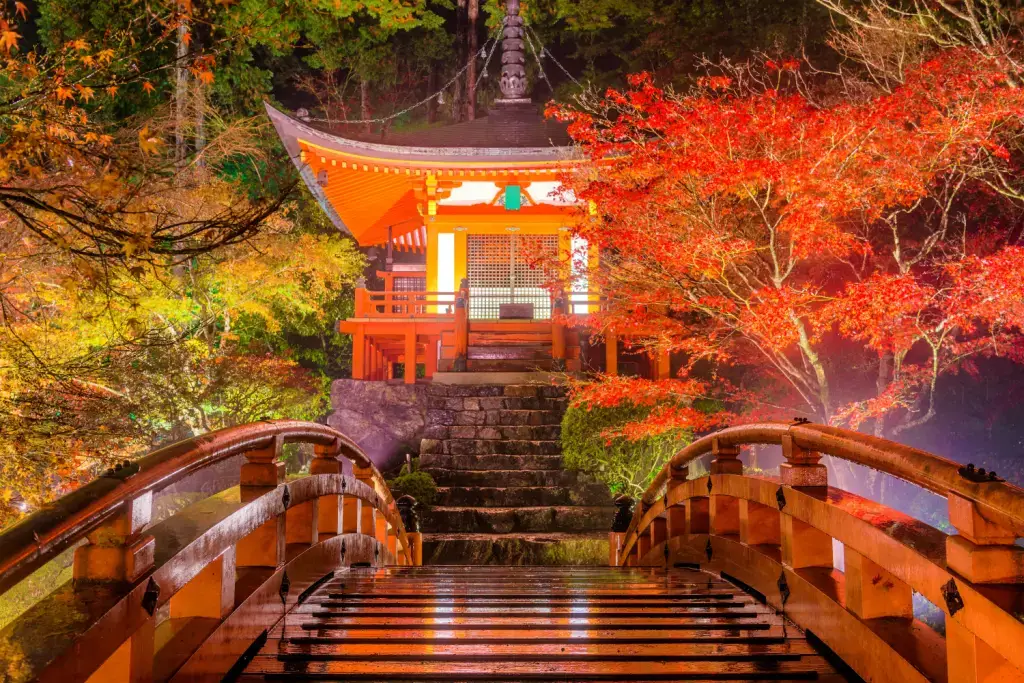
In Kyoto, koyo is celebrated as one of the most picturesque times of the year. Throughout Kyoto, locals and tourists participate in “momijigari,” hunting for red leaves, as they go to famous spots to enjoy the autumn colors. Kyoto’s blend of tradition, spirituality, and natural beauty makes it one of the top destinations for experiencing koyo. Let’s look at some of the best places in Kyoto to enjoy the red leaves!
What is “koyo”?
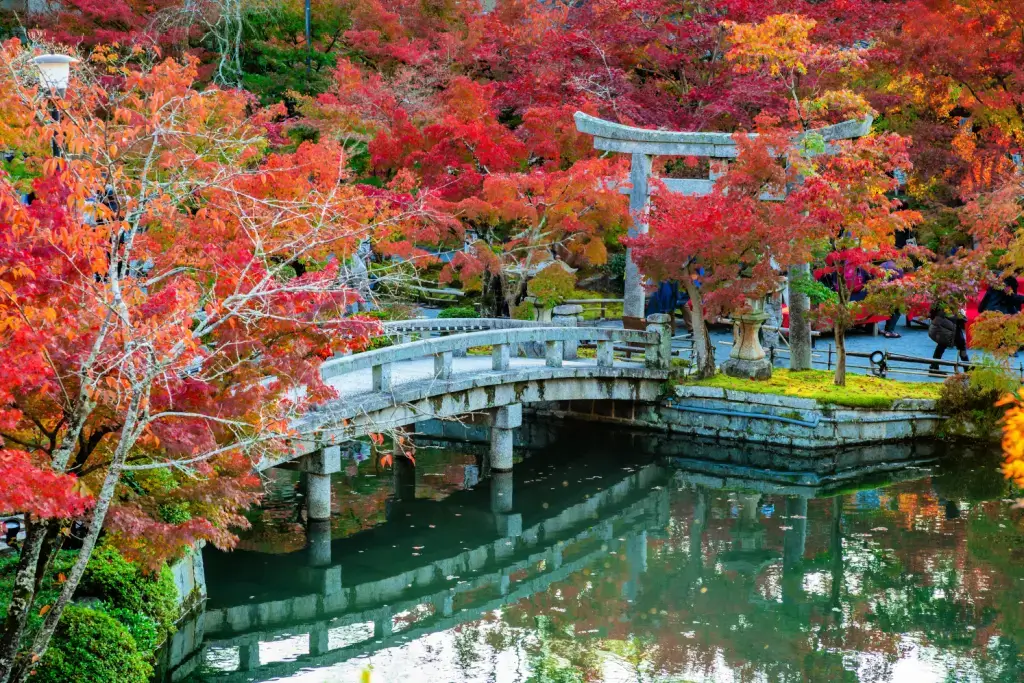
Koyo means “red leaves” in Japanese and refers to the beautiful transformation of the leaves during autumn. The term is associated with the changing colors of maple leaves, which turn red, orange, and yellow. This seasonal shift is like cherry blossom viewing in the spring, but koyo showcases autumn’s warm tones. The significance of koyo runs deep in Japan, as it has been admired in art and literature for centuries.
Kiyomizu-dera Temple
Kiyomizu-dera Temple is one of Kyoto’s most famous landmarks, becoming even more spectacular during the koyo season. This Buddhist temple offers stunning views of the red-leafed forest that surrounds it. The temple is known for its large terrace, which provides visitors with a vantage point to see the autumn colors. During peak koyo, evening illuminations bathe the temple and the surrounding foliage in a warm, golden glow.
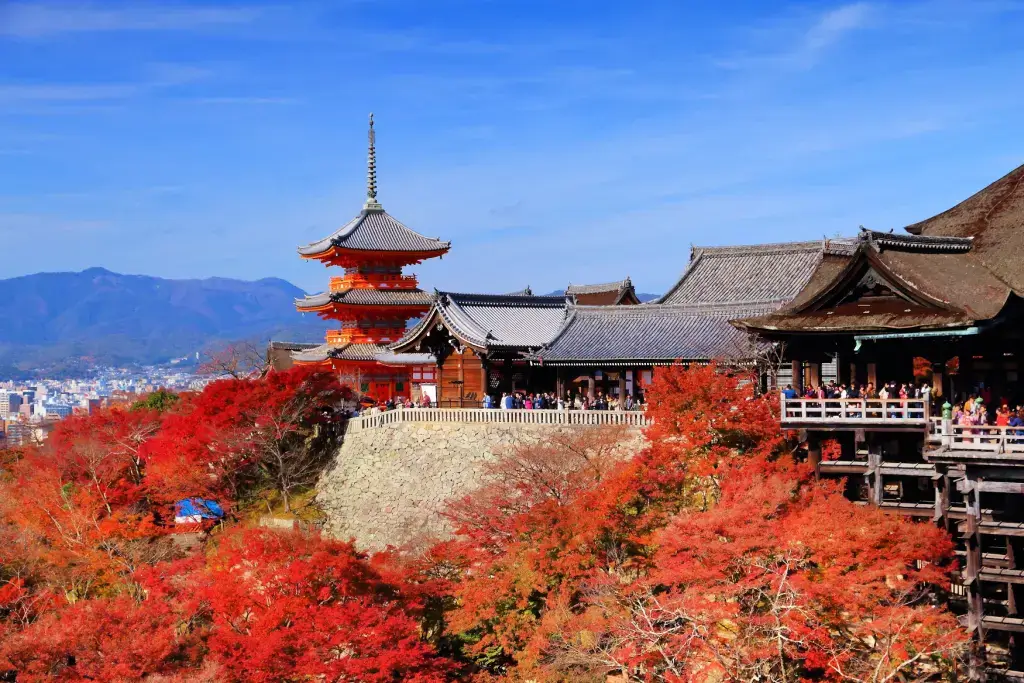
The temple grounds are extensive, with numerous paths winding through gardens and smaller shrines, each offering unique perspectives of the autumn scenery. As you explore Kiyomizu-dera, the contrast between the wooden structures and the red leaves creates a timeless atmosphere. Kiyomizu-dera, during koyo season, is a place where history, culture, and nature blend seamlessly, providing a breathtaking experience.
Are you looking for great snacks to enjoy for this koyo season? Check out Sakuraco! Sakuraco delivers traditional Japanese snacks, sweets, tableware, and more from local Japanese makers right to your door, perfect for a pleasant snack time at home!

Heian Shrine
Heian Shrine is known for its expansive gardens that become a sea of red during koyo season. During autumn, vibrant colors from Japanese maples and other trees transform the shrine’s garden, which surrounds a serene pond. The red leaves reflect on the water’s surface, adding a magical quality to the experience and creating a perfect spot for koyo viewing.
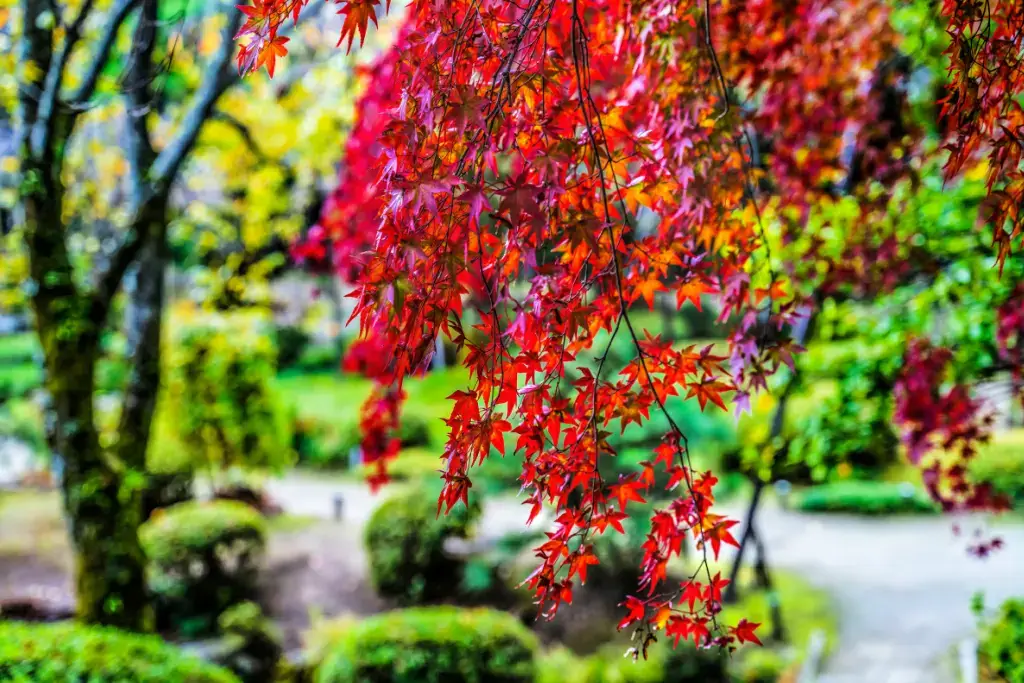
The wide, open spaces of the shrine grounds offer a peaceful contrast to the bustling streets of Kyoto. They invite visitors to slow down and appreciate the surrounding beauty. As you wander through the gardens, the leaves and crisp autumn air connect you with the season. Heian Shrine gains fame during koyo for its evening illuminations. These lights highlight the autumn colors and cast stunning shadows and reflections, making them ideal for photography.
Sagano Romantic Train
The Sagano Romantic Train offers a journey through the heart of Kyoto’s autumn landscape. This train ride takes passengers on a 25-minute trip through the picturesque Arashiyama area, following the Hozu River. The open-air cars of the train allow you to immerse yourself in autumn. As the train moves slowly along the track, passengers are treated to breathtaking views of red, orange, and yellow leaves along the mountainsides.
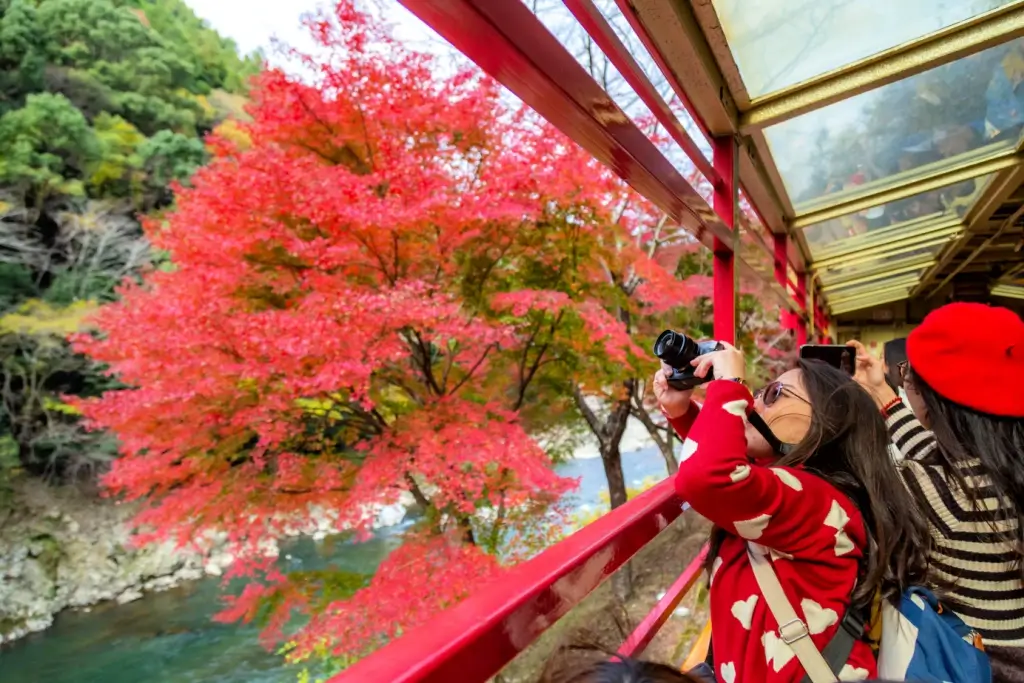
Riding the Sagano Romantic Train during koyo season feels like stepping into a living postcard. The train journey is particularly popular with photographers, as the changing light and landscape offer endless opportunities to capture the season’s beauty. The Sagano Romantic Train is perfect for those who want to enjoy koyo while experiencing one of Kyoto’s most scenic and tranquil areas.
Kyoto Botanical Garden
Kyoto Botanical Garden is a spectacular spot to enjoy koyo. The garden hosts various plant species, including several types of Japanese maples that turn brilliant red and gold in autumn. Its layout mixes formal landscapes with naturalistic settings, allowing visitors to experience cultivated beauty and wild nature.
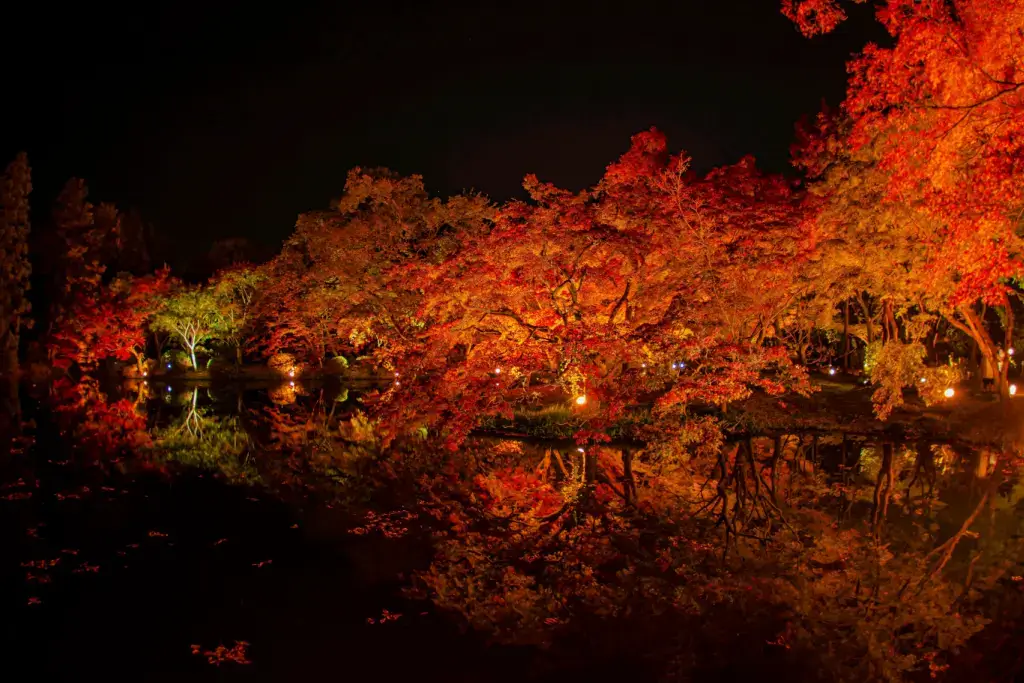
The garden is perfect for anyone wanting to enjoy autumn’s beauty. It features a range of walking paths that lead through different sections, each offering unique views of the autumn colors. Besides maples, the garden also has ginkgo trees. Their bright yellow leaves provide a stunning contrast to the deep reds of the maples.
Why is koyo season in Kyoto so special?
People flock to Kyoto during koyo season for its historical sites and natural beauty. The city offers a perfect autumn backdrop. Kyoto’s koyo is unique as it blends the natural world with centuries-old cultural landmarks. Bright red leaves framing ancient temples and traditional tea houses create a captivating Japanese aesthetic.
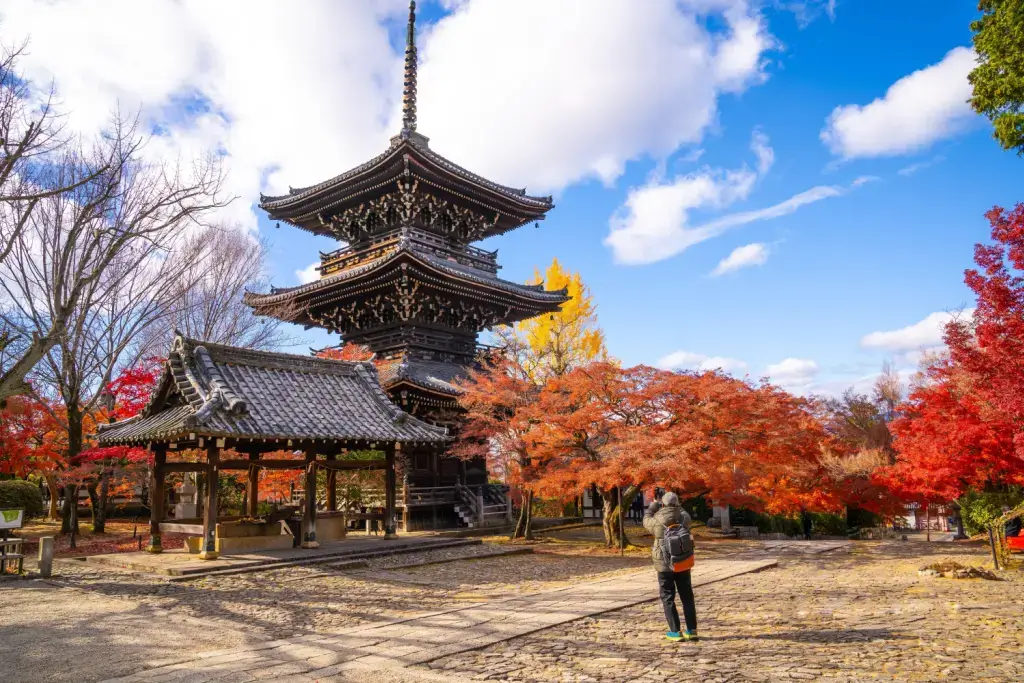
Kyoto’s koyo season offers a variety of experiences. Visitors can view leaves from Kiyomizu-dera’s terrace, stroll through the botanical garden, or ride the Sagano Romantic Train. The city’s koyo illuminations add another layer of magic. At night, temples and gardens are lit up, making the experience unforgettable.
Have you enjoyed koyo in Kyoto? Where did you go? Let us know in the comments below!

Discover authentic flavors with Sakuraco
Get Sakuraco 

Discover authentic flavors with Sakuraco
Get Sakuraco 
Related Articles

Japanese Fish Bait: The Beautiful Art of Kebari
Kebari are traditional hand-tied flies used for freshwater fishing in Japan, especially in mountain streams where small insects form the main diet of native fish. Instead of bright plastic lures, kebari use feathers, thread, and natural materials to create subtle movements in the water.

Japan Holidays Guide: Relax, Explore, and Delight in Festive Fun
As the year draws to a close, everywhere buzzes with preparations for the holidays, and Japan is no exception. Despite the cold winter weather, you can feel warmth in the scenery, decorations, and festive activities across the country. Let’s explore the unique experiences of holidays in Japan that many people dream of enjoying at least once in their lifetime!

Tokyo Gardens: Five Beautiful Traditional Japanese Gardens to Visit
Tokyo gardens offer a relaxing escape for visitors looking to get a breath of fresh air. However, Tokyo has more than just the typical gardens we see in the West. Let’s explore five traditional Japanese gardens and what makes them unique!

Japan Cruise Spotlight: The Ultimate Guide to Abashiri Icebreaker!
Japan offers a diverse range of cruise experiences, taking in various stunning landscapes. But, in the chilly grip of winter, some voyages pull in adventurers from around the globe. At the forefront of these wintry trips is the Abashiri Icebreaker Cruise in Hokkaido.


